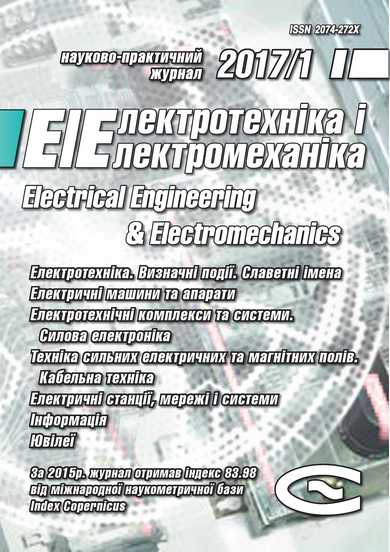ON SUBSTANTIATION OF SELECTION OF ECONOMIC AND MATHEMATICAL METHODS FOR THE ASSESSMENT OF ENERGY EFFICIENCY OF PRODUCTION FACILITIES
DOI:
https://doi.org/10.20998/2074-272X.2017.1.11Keywords:
электропотребление, равновесные и неравновесные критерии, энергоэффективность, коэффициент автокорреляцииAbstract
Research purpose is generalization and further development of economic- mathematical methods for ensuring energy-efficient operation mode of production facilities. The above methods can be used for selection of the most energy-efficient production lines, mechanisms; pumping, compression, ventilation installations or other electric receivers among several similar ones by using equal and unequal weight criteria. An example of comparing the efficiency of the production facilities of the chemical industry is showed by a priori ranking and morphological (geometric) methods. The method of control the correctness of the production facilities in the case when the electric load depends on two parameters in triangular coordinates in the presence of boundary restrictions is described. The identity of the current energy values calculated by Holt predicted value at a predetermined optimal smoothing constant determines the stability of the process. Expedience of application the autocorrelation coefficient for testing processes on the stability is proved.References
1. Denysenko M. A. Spetsial'ni pytannya elektropostachannya: navch. posib. Ch.I.: Vybir elementiv elektropostachal'nykh system na osnovi stokhastychnoho modelyuvannya protsesiv, shcho vidbuvayut'sya v nykh [Special issues of power supply. Part 1. Selecting items of electricity supply systems based on stochastic modeling of processes occurring in them]. Kyiv, NTUU «KPI» Publ., 2009. 288 p. (Ukr).
2. Zamulko A.I., Bederak Ya.S. Comprehensive statistical data analysis of active power consumption, energy expenditures and production volumes. Power Engineering: Economics, Technique, Ecology, 2014, no.2, pp. 79-83. (Ukr).
3. Gorbunov V.M. Teoriia priniatiia reshenii [Decision making theory]. Tomsk, NRTPU Publ., 2010. 67 p. (Rus).
4. Uiler D., Chambers D. Statisticheskoe upravlenie protsessami. Optimizatsiia biznesa s ispol'zovaniem kontrol'nykh kart Shukharta [Statistical control of process. Optimization of business using Shewhart control charts]. Мoscow, Alpina Business Books Publ., 2008. 419 p. (Rus).
5. Bederak Ya.S. Visualization of reports and templates, which are formed in the monitoring systems of power consumption and energy management. Bulletin of Kharkiv Petro Vasylenko National Technical University of Agriculture, 2012, no.130, pp. 3-5. (Ukr).
6. Voloshko A.V., Bederak Ya.S., Lutchyn T.M. The problems of selection of optimal mathematical model of energy consumption at industrial enterprises. Eastern-European Journal of Enterprise Technologies, 2013, no.5/8(65), pp. 19-23. (Ukr). doi: 10.15587/1729-4061.2013.18122.
7. Nakhodov V.F., Borychenko O.V. Monitoring and analysis of implementation of established «standards» in the statistical control systems of effective use of electric energy. Informational collected papers «Promyslova electroenergetyka ta elektrotekhnyka» Promelektro, 2011, no.2, pp. 16-23. (Ukr).
8. Stetsenko Y.V., Bederak Ya.S. Recovery and operational forecasting by Holt’s method of electricity consumption at enterprises with a continuous work cycle. Electronic modeling, 2015, no.4, pp. 119-126. (Rus).
9. Luk’yanenko I.G., Krasnikova L.I. Ekonometryka [Econometrics]. Kyiv, Tovaristvo «Znannya» KOO Publ., 1998. 494 p. (Ukr).
10. Kobets B.B., Volkova I.O. Innovatsionnoe razvitie elektroenergetiki na baze kontseptsii Smart Grid [Innovative development of the electric power on the basis of Smart Grid concept]. Moscow, IAC Energiya Publ., 2010, 208 p. (Rus).
Downloads
Published
How to Cite
Issue
Section
License
Copyright (c) 2017 Ya. S. Bederak

This work is licensed under a Creative Commons Attribution-NonCommercial 4.0 International License.
Authors who publish with this journal agree to the following terms:
1. Authors retain copyright and grant the journal right of first publication with the work simultaneously licensed under a Creative Commons Attribution License that allows others to share the work with an acknowledgement of the work's authorship and initial publication in this journal.
2. Authors are able to enter into separate, additional contractual arrangements for the non-exclusive distribution of the journal's published version of the work (e.g., post it to an institutional repository or publish it in a book), with an acknowledgement of its initial publication in this journal.
3. Authors are permitted and encouraged to post their work online (e.g., in institutional repositories or on their website) prior to and during the submission process, as it can lead to productive exchanges, as well as earlier and greater citation of published work.





